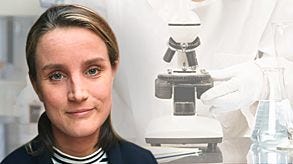Maartje van der Heijden describes her work studying factors that influence the evolutionary process of intestinal (pre)malignant growth
Organoids and Colorectal Cancer - Novel Models to Find New Therapies

The Scientist
What inspired you to pursue scientific research?
From early on in my medical career the field of oncology interested me. However, I felt that classes on this topic were far from sufficient in order for me to develop a profound understanding of the biology of this disease. For this reason, I was eager to be involved in cancer research and started working as a student-assistant in a laboratory during my studies at medical school.
Do you have a scientific idol that influenced the scientific path you’ve chosen?
Marie Curie, one of the leading scientists in the field of radioactivity. Her efforts and experimental work in the late 19th century led to the discovery of the treatment properties of radiation for malignancies. But even more, she was the first woman to be win a Nobel prize and the only person who is awarded two Nobel prizes in two different fields of study. Her tremendous achievements for the advances in science are without doubt very much inspirational. Especially considering the fact that she was working in a scientific climate which was dominated by men.
What led you to studies in your current field?
I have always been intrigued by the far-reaching effects, namely malignant outgrowth and eventually metastasis, of what starts as minor genetic changes in normal (stem) cells. For this reason, I was excited to start my PhD research studying at the intersection between stem cells and cancer.
What hobbies do you have outside of the lab?
Art, hiking, reading, meeting friends and spending time with family.
The Science
Please describe the focus of your current research.
Broadly, we aim to capture and manipulate the factors that influence the evolutionary process of intestinal (pre)malignant growth. For example, I am studying the clonal growth dynamics of intestinal adenomas and colorectal cancer in homeostasis and under drug pressure. Furthermore, I am validating the findings of our recent paper on the role of Bcl-2 in malignant transformation of intestinal stem cells, in a human model. We aim to develop a novel chemo-preventive method for patients who are genetically predisposed to developing colorectal cancer.
What do you consider to be the most important advance(s) in intestinal research and/or research into intestinal cancers in the last five years?
The state-of-the-art organoid culture systems have been an enormous addition to the research tools available for studying intestinal cellular behavior within homeostasis and disease in a culture dish, and therefore highly impact the approach of intestinal research today and in the coming years.
What breakthroughs would you anticipate in the next five years?
Novel genome engineering and culturing technologies have recently been adapted by many research groups worldwide, for example the CRISPR/Cas9 tool and organoid culturing, respectively. These methods enable researchers to study the complex underpinnings of human multi-cellular compositions in a relatively swift manner. Consequently, this will accelerate the progress being made in the biomedical sciences substantially. Another breakthrough I would expect in the next five years, is the optimization of colorectal cancer prevention and treatment by taking advantage of the plethora of anti-cancer therapies that have been developed or are underway. Moreover, the crossroads between biology and nanotechnology are increasingly being explored which potentially provides us with a whole new set of opportunities for cancer diagnosis, prevention and treatment.
What impact do you see organoids having on the intestinal field? What technical hurdles remain before this can be realised?
Intestinal organoids give researchers the opportunity to closely study intestinal cellular systems under different circumstances. For example, they are useful in both high-throughput phenotypic analyses and drug screenings. However, the interaction between stromal, immunological, microbiological and epithelial cellular compartments adds another layer of complexity that cannot be addressed at this point and remains a major challenge to mimic in in vitro systems.
Featured Publications:
- van der Heijden M. et al. (2016) Bcl-2 is a critical mediator of intestinal transformation. Nat Commun. 7:10916.
- Vermeulen L. et al. (2013) Defining stem cell dynamics in models of intestinal tumor initiation. Science 342(6161):995-8.
Request Pricing
Thank you for your interest in this product. Please provide us with your contact information and your local representative will contact you with a customized quote. Where appropriate, they can also assist you with a(n):
Estimated delivery time for your area
Product sample or exclusive offer
In-lab demonstration


